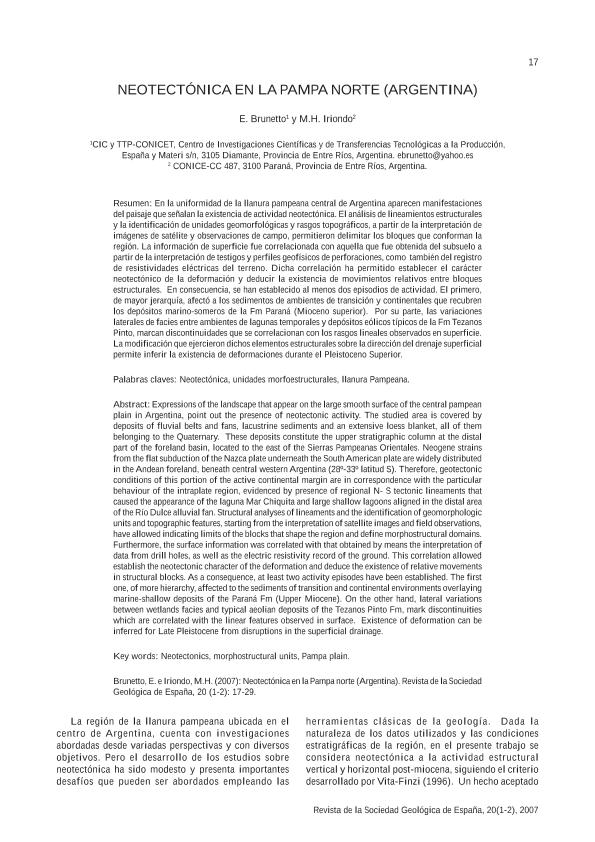Mostrar el registro sencillo del ítem
dc.contributor.author
Brunetto, Ernesto

dc.contributor.author
Iriondo, Martin Horacio

dc.date.available
2019-08-05T14:14:51Z
dc.date.issued
2007-12
dc.identifier.citation
Brunetto, Ernesto; Iriondo, Martin Horacio; Neotectónica en la Pampa Norte (Argentina); Sociedad Geológica de España; Revista de la Sociedad Geológica de España; 20; 1-2; 12-2007; 17-29
dc.identifier.issn
0214-2708
dc.identifier.uri
http://hdl.handle.net/11336/80899
dc.description.abstract
En la uniformidad de la llanura pampeana central de Argentina aparecen manifestaciones del paisaje que señalan la existencia de actividad neotectónica. El análisis de lineamientos estructurales y la identificación de unidades geomorfológicas y rasgos topográficos, a partir de la interpretación de imágenes de satélite y observaciones de campo, permitieron delimitar los bloques que conforman la región. La información de superficie fue correlacionada con aquella que fue obtenida del subsuelo a partir de la interpretación de testigos y perfiles geofísicos de perforaciones, como también del registro de resistividades eléctricas del terreno. Dicha correlación ha permitido establecer el carácter neotectónico de la deformación y deducir la existencia de movimientos relativos entre bloques estructurales. En consecuencia, se han establecido al menos dos episodios de actividad. El primero, de mayor jerarquía, afectó a los sedimentos de ambientes de transición y continentales que recubren los depósitos marino-someros de la Fm Paraná (Mioceno superior). Por su parte, las variaciones laterales de facies entre ambientes de lagunas temporales y depósitos eólicos típicos de la Fm Tezanos Pinto, marcan discontinuidades que se correlacionan con los rasgos lineales observados en superficie. La modificación que ejercieron dichos elementos estructurales sobre la dirección del drenaje superficial permite inferir la existencia de deformaciones durante el Pleistoceno Superior.
dc.description.abstract
Expressions of the landscape that appear on the large smooth surface of the central pampean plain in Argentina, point out the presence of neotectonic activity. The studied area is covered by deposits of fluvial belts and fans, lacustrine sediments and an extensive loess blanket, all of them belonging to the Quaternary. These deposits constitute the upper stratigraphic column at the distal part of the foreland basin, located to the east of the Sierras Pampeanas Orientales. Neogene strains from the flat subduction of the Nazca plate underneath the South American plate are widely distributed in the Andean foreland, beneath central western Argentina (28º-33º latitud S). Therefore, geotectonic conditions of this portion of the active continental margin are in correspondence with the particular behaviour of the intraplate region, evidenced by presence of regional N- S tectonic lineaments that caused the appearance of the laguna Mar Chiquita and large shallow lagoons aligned in the distal area of the Río Dulce alluvial fan. Structural analyses of lineaments and the identification of geomorphologic units and topographic features, starting from the interpretation of satellite images and field observations, have allowed indicating limits of the blocks that shape the region and define morphostructural domains. Furthermore, the surface information was correlated with that obtained by means the interpretation of data from drill holes, as well as the electric resistivity record of the ground. This correlation allowed establish the neotectonic character of the deformation and deduce the existence of relative movements in structural blocks. As a consequence, at least two activity episodes have been established. The first one, of more hierarchy, affected to the sediments of transition and continental environments overlaying marine-shallow deposits of the Paraná Fm (Upper Miocene). On the other hand, lateral variations between wetlands facies and typical aeolian deposits of the Tezanos Pinto Fm, mark discontinuities which are correlated with the linear features observed in surface. Existence of deformation can be inferred for Late Pleistocene from disruptions in the superficial drainage.
dc.format
application/pdf
dc.language.iso
spa
dc.publisher
Sociedad Geológica de España
dc.rights
info:eu-repo/semantics/openAccess
dc.rights.uri
https://creativecommons.org/licenses/by-nc-sa/2.5/ar/
dc.subject
Neotectónica
dc.subject
Unidades Morfoestructurales
dc.subject
Llanura Pampeana
dc.subject.classification
Geología

dc.subject.classification
Ciencias de la Tierra y relacionadas con el Medio Ambiente

dc.subject.classification
CIENCIAS NATURALES Y EXACTAS

dc.title
Neotectónica en la Pampa Norte (Argentina)
dc.type
info:eu-repo/semantics/article
dc.type
info:ar-repo/semantics/artículo
dc.type
info:eu-repo/semantics/publishedVersion
dc.date.updated
2019-08-01T13:41:05Z
dc.journal.volume
20
dc.journal.number
1-2
dc.journal.pagination
17-29
dc.journal.pais
España

dc.journal.ciudad
Zaragoza
dc.description.fil
Fil: Brunetto, Ernesto. Provincia de Entre Ríos. Centro de Investigaciones Científicas y Transferencia de Tecnología a la Producción. Universidad Autónoma de Entre Ríos. Centro de Investigaciones Científicas y Transferencia de Tecnología a la Producción. Consejo Nacional de Investigaciones Científicas y Técnicas. Centro Científico Tecnológico Conicet - Santa Fe. Centro de Investigaciones Científicas y Transferencia de Tecnología a la Producción; Argentina
dc.description.fil
Fil: Iriondo, Martin Horacio. Consejo Nacional de Investigaciones Científicas y Técnicas; Argentina
dc.journal.title
Revista de la Sociedad Geológica de España
dc.relation.alternativeid
info:eu-repo/semantics/altIdentifier/url/http://www.sociedadgeologica.es/archivos/REV/20(1-2)/Art02.pdf
Archivos asociados
